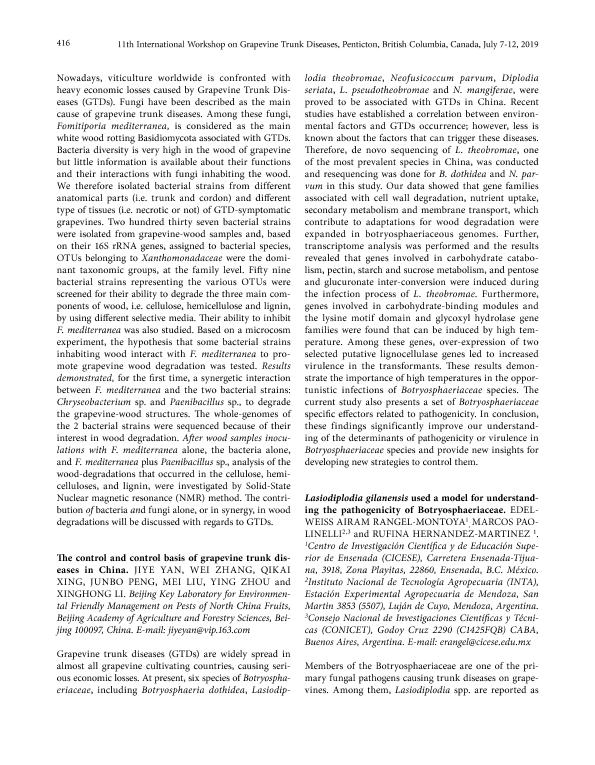Mostrar el registro sencillo del ítem
dc.contributor.author
Rangel Montoya Edelweiss
dc.contributor.author
Paolinelli, Marcos

dc.contributor.author
Hernández Martínez Rufina
dc.date.available
2022-04-20T17:24:19Z
dc.date.issued
2019
dc.identifier.citation
Lasiodiplodia gilanensis used as model for understanding the pathogenicity of Botryosphaeriaceae; 11th International Workshop on grapevine trunk diseases; Penticton; Canadá; 2019; 416 - 417
dc.identifier.issn
0031-9465
dc.identifier.uri
http://hdl.handle.net/11336/155456
dc.description.abstract
Lasiodiplodia spp. cause degenerative diseases, dieback and plant death in a wide range of woody plants. To understand the fungal behavior of the genus we are using Lasiodiplodia gilanensis as a model. A transcriptional study revealed that the fungus is capable of using the phenylpropanoid precursors and salicylic acid to avoid the host defense response of the plant. On another hand, several genes encoding enzymes involved in different melanin synthesis pathways; 3,4-dihydroxyphenylalanine (DOPA)-melanin, 1,8-dihydroxynaphthalene (DHN)-melanin and pyomelanin; were identified and their production evauated, concluding that the fungus use diferent types of melanin to overcome environmental stress. An in silico analysis shows the presence of those genes in all the available genomes of Botryosphaeriaceae in the GeneBank, evidencing the importance of the melanin in this family. L. gilanensis produces siderophores of catechol and hydroxamate-type as well as naturally esterified fatty acids that might have a role in plant growth regulation. A plethora of hydrolytic enzymes is also produced, including xylanases, ligninases, cellulases, pectinases, cutinases, and hemicelluloses. Another secondary metabolite produced is oxalic acid, reported as a pathogenicity factor in other fungi, which role is under evaluation. Microscopical observations showed that the fungus uses the starch deposited in the ray cells as carbon source, induces the production of suberin and phenolic compounds and colonizes the vascular cambium, ray parenchyma, and the vascular bundles. These studies extend our understanding of the pathogenicity of a widely distributed pathogenic fungus with our final goal to control the diseases it causes.
dc.format
application/pdf
dc.language.iso
eng
dc.publisher
Firenze University Press
dc.rights
info:eu-repo/semantics/openAccess
dc.rights.uri
https://creativecommons.org/licenses/by/2.5/ar/
dc.subject
PCWDEs
dc.subject
polyphenolic
dc.subject
Tyrosine catabolism
dc.subject
melanin
dc.subject.classification
Biotecnología Agrícola y Biotecnología Alimentaria

dc.subject.classification
Biotecnología Agropecuaria

dc.subject.classification
CIENCIAS AGRÍCOLAS

dc.title
Lasiodiplodia gilanensis used as model for understanding the pathogenicity of Botryosphaeriaceae
dc.type
info:eu-repo/semantics/publishedVersion
dc.type
info:eu-repo/semantics/conferenceObject
dc.type
info:ar-repo/semantics/documento de conferencia
dc.date.updated
2022-03-16T20:59:00Z
dc.identifier.eissn
1593-2095
dc.journal.volume
58
dc.journal.number
2
dc.journal.pagination
416 - 417
dc.journal.pais
Italia

dc.journal.ciudad
Firenze
dc.description.fil
Fil: Rangel Montoya Edelweiss. Consejo Nacional de Ciencia y Tecnología de México. Centro de Investigación Científica y de Educación Superior de Ensenada Baja California; México
dc.description.fil
Fil: Paolinelli, Marcos. Instituto Nacional de Tecnología Agropecuaria. Centro Regional Mendoza-San Juan. Estación Experimental Agropecuaria Mendoza; Argentina. Consejo Nacional de Investigaciones Científicas y Técnicas; Argentina
dc.description.fil
Fil: Hernández Martínez Rufina. Consejo Nacional de Ciencia y Tecnología de México. Centro de Investigación Científica y de Educación Superior de Ensenada Baja California; México
dc.relation.alternativeid
info:eu-repo/semantics/altIdentifier/url/https://ucanr.edu/sites/ICGTD/files/343537.pdf
dc.relation.alternativeid
info:eu-repo/semantics/altIdentifier/doi/http://dx.doi.org/10.14601/Phytopathol_Mediter-10627
dc.relation.alternativeid
info:eu-repo/semantics/altIdentifier/url/https://oajournals.fupress.net/index.php/pm/article/view/10627/10622
dc.conicet.rol
Autor

dc.conicet.rol
Autor

dc.conicet.rol
Autor

dc.coverage
Internacional
dc.type.subtype
Workshop
dc.description.nombreEvento
11th International Workshop on grapevine trunk diseases
dc.date.evento
2019-07-07
dc.description.ciudadEvento
Penticton
dc.description.paisEvento
Canadá

dc.type.publicacion
Journal
dc.description.institucionOrganizadora
Oregon Wine Research Institute
dc.source.revista
Phytopathologia Mediterranea
dc.date.eventoHasta
2019-07-12
dc.type
Workshop
Archivos asociados
